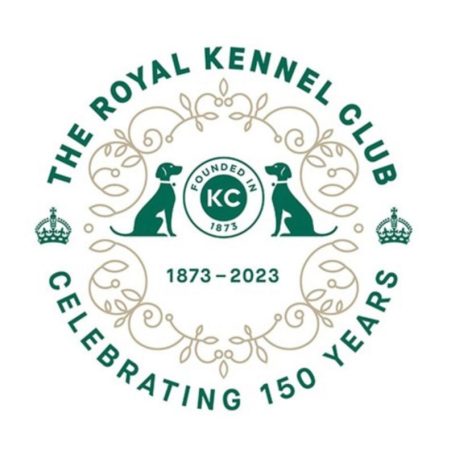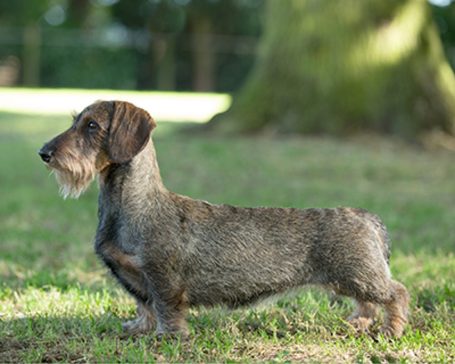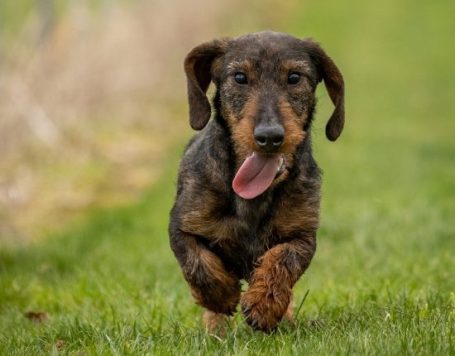








Some More Information
Just some information about the breed which you may find interesting. (Excuse the American Articles)
Kennel Club Description of the Breed
The origins of the Dachshund can be traced back to working dogs that could go to ground after game such as badgers and rabbits, or to track fallen/wounded deer. Today, Dachshunds are very popular as intelligent and faithful pets, both for town and country dwellers. In the UK the Dachshund comes in six varieties, two sizes – Standards weighing up to 12 kg (26 lbs) and Miniatures ideally weighing 4.5 kg (10 lbs) and no more than 5 kg (11 lbs) - and three coats – Smooth-haired, Long-haired & Wire-haired. Germany is the breed’s home country where sizes are separated not by weight but by chest circumference, with three sizes being based on what size of hole they could enter when going to ground. All in all, a marvellous selection of attractive and sporting dogs.
Dachshunds are active dogs and, once fully mature, will take as much exercise as you can give them and you are likely to want to go home before they do. They are, however, just as happy curled up on your lap, snoozing. They are loyal companions and generally make good family pets. They are not noted for their obedience but, with patience and persistence by the owner, they can be trained. However, they are Hounds and when they are off the lead, if they get a scent, they can “go deaf” when it suits them.
Temperamentally all six varieties are very good at giving a good account of themselves and, as such, are excellent house-dogs who will guard your property from any unwelcome guests. His bark can be deep, especially in the Standards, and people are often surprised to hear such a deep noise coming from a dog the size of a Dachshund.
The breed is characterised as moderately long and low with no exaggerations, and should have a well-muscled body with enough ground clearance to allow free movement. The front feet are used for digging and should be big, broad and well-arched, point forward, or only slightly turned outwards. As befits his working origins, the Dachshund should have strong teeth and a powerful jaw.
The Dachshund is a short-legged dog, not a long-backed one. Excessive length can lead to problems with back disease. It is important that the ribbing should extend well back and the loin should be short and strong
The Wires should have short, straight, harsh hair with a dense undercoat. There is a beard on the chin, the eyebrows are bushy, but the hair on ears is almost smooth. Coat texture can vary but most Wire coats will need to be hand-stripped a couple of times each year. Weekly grooming with a comb and stiff brush is also essential. Most common colour is Brindle (also known as Wild Boar). As a generalisation, the Wires are the most extrovert and active of the varieties and really love the great outdoors.
History
Some writers and dachshund experts have theorized that the early roots of the dachshund go back to ancient Egypt, where engravings were made featuring short-legged hunting dogs. Recent discoveries by the American University in Cairo of mummified dachshund-like dogs from ancient Egyptian burial urns may lend credibility to this theory. In its modern incarnation, the dachshund is a creation of German breeders and includes elements of German, French, and English hounds and terriers. Dachshunds have been kept by royal courts all over Europe, including that of Queen Victoria, who was particularly enamoured of the breed. They were originally bred for hunting badgers by trailing scent. The first verifiable references to the dachshund, originally named the "Dachs Kriecher" ("badger crawler") or "Dachs Krieger" ("badger warrior"), came from books written in the early 18th century. Prior to that, there exist references to "badger dogs" and "hole dogs", but these likely refer to purposes rather than to specific breeds. The original German dachshunds were larger than the modern full-size variety, weighing between 30 and 40 lb (14 and 18 kg), and originally came in straight-legged and crook-legged varieties (the modern dachshund is descended from the latter). Though the breed is famous for its use in exterminating badgers and badger-baiting, dachshunds were also commonly used for rabbit and fox hunting, for locating wounded deer, and in packs were known to hunt game as large as wild boar and as fierce as the wolverine.
The Old Fashioned Dachshund
There are huge differences of opinion as to when dachshunds were specifically bred for their purpose of badger hunting, as the American Kennel Club states the dachshund was bred in the 15th century, while the Dachshund Club of America states that foresters bred the dogs in the 18th or 19th century. Double-dapple dachshunds, which are prone to eye disease, blindness, or hearing problems, are generally believed to have been introduced to the United States between 1879 and 1885. The flap-down ears and famous curved tail of the dachshund have deliberately been bred into the dog. In the case of the ears, this is so that grass seeds, dirt, and other matter do not enter the ear canal. The curved tail is dual-purposed: to be seen more easily in long grass and, in the case of burrowing dachshunds, to help haul the dog out if it becomes stuck in a burrow. The smooth-haired dachshund, the oldest style, may be a cross between the German Shorthaired Pointer, a Pinscher, and a Bracke (a type of bloodhound), or to have been produced by crossing a short Bruno Jura Hound with a pinscher. Others believe it was a cross from a miniature French pointer and a pinscher; others claim that is was developed from the St. Hubert Hound, also a bloodhound, in the 18th century, and still others believe that they were descended from Basset Hounds, based upon their scent abilities and general appearance. The exact origins of the dachshund, then, are unknown. According to William Loeffler, from The American Book of the Dog (1891), in the chapter on Dachshunds:"The origin of the Dachshund is in doubt, our best authorities disagreeing as to the beginning of the breed." What can be agreed on, however, is that the short-haired dachshund gave rise to both the long-haired and the wire-haired varieties. There are two theories regarding how the standard longhair dachshund came about. One theory is that smooth Dachshunds would occasionally produce puppies which had slightly longer hair than their parents. By selectively breeding these animals, breeders eventually produced a dog which consistently produced longhair offspring, and the longhair dachshund was born. Another theory is that the standard longhair dachshund was developed by breeding smooth dachshunds with various land and water spaniels. The long-haired dachshund may be a cross among any of the small dog breeds in the spaniel group, including the German Stoberhund, and the smooth-haired dachshund. The wire-haired dachshund, the last to develop, was created in late 19th century. There is a possibility the wire-haired dachshund was a cross between the smooth dachshund and various hard-coated terriers and wire-haired pinschers, such as the Schnauzer, the Dandie Dinmont Terrier, the German Wirehaired Pointer, or perhaps the Scottish Terrier.
Dachshund and badger
Dachshunds have traditionally been viewed as a symbol of Germany. Political cartoonists commonly used the image of the dachshund to ridicule Germany. During World War I the dachshunds' popularity in the United States plummeted because of this association and there are even anecdotes such as a Dachshund being stoned to death on the high street of Berkhamsted, England at this time because of its association with the enemy . As a result they were often called "liberty hounds" by their owners similar to "liberty cabbage" becoming a term for sauerkraut. The stigma of the association was revived to a lesser extent during World War II, though it was comparatively short-lived. Kaiser Wilhelm II and German Field Marshal Erwin Rommel were known for keeping dachshunds. Due to the association of the breed with Germany, the dachshund was chosen to be the first official mascot for the 1972 Summer Olympics in Munich, with the name Waldi.
Sports
Believe it or not the dachshund is a very trainable dog. Willful and brave and often stubborn but they love having a job to do. They are obviously used for hunting and are a great success in tracking wounded animals, working in a pack for boar hunting and as is often seen collecting shot birds on shoots. This is not everyones ideal fun day out so instead you can use their inate abilities of scenting, hearing, seeing and being low to the ground for many other sports. In Amercia they have dachshund racing but despite this being extremely popular not something that is recommended so we dont encourage this sport. They are very fast and if you have seen a dachshund in full flight you will know how quick they are often looking like they are flying with all four legs off the ground.
Dog agility is a popular sport and although the main stream event is perhaps a bit much, scaled down obstacles are perfect. Again it uses their ability to run, follow orders and have fun. Usually if there is a tasty treat to be had. The relatively new sport of Hoopers is perfect for them as this is a course of low to the ground obstacles including hoops. Another great idea for activities with them is Scent Trailing where a trail is laid and the dog has to follow it. This is a great way to use your dachshunds nose and can be great fun for dog and handler.
Dog shows are perhaps the best known activity for all breeds of dog and the dachshund is well represented at most of the shows not only here in the UK but overseas. The Club will give anyone help if they wish to partake as it is a huge subject to discuss and too complicated to go into here but can be a great day out talking to like minded people and showing off your well trained and perfect specimen.
Wire haired dachshund in other parts of the world
Dackel versus Teckel In Germany, dachshunds are widely called Dackel (both singular and plural). To be classified as a full Teckel, these dogs must undergo blood tracking tests. Classically, any dog of Dackel heritage is given an official tattoo upon one ear. After suitable training, the dog must then follow a blood trail that is at least 48 hours old successfully to its conclusion. Once this is completed, another tattoo is marked on the other ear to denote full Teckel rank. Teckel, whether tattooed or not, are bred for hunting purposes, and they tend to be visibly larger in their chests than their Dackel counterparts, though marginally shorter in length.
Notable dogs and owners
• John F. Kennedy bought a dachshund puppy while touring Europe in 1937 for his then girlfriend Olivia. The puppy, named Dunker, never left Germany
• Grover Cleveland, the 22nd and 24th President, had a dachshund in the White House.[68] • William Randolph Hearst was an avid lover of dachshunds. When his own dachshund Helena died, he eulogized her in his "In The News" column.
• Fred, E.B. White's dachshund, appeared in many of his famous essays.
• Lump, the pet of Pablo Picasso, who was thought to have inspired some of his artwork. (Pronounced: loomp; German for "Rascal") Picasso & Lump: A Dachshund's Odyssey tells the story of Picasso and Lump.
• Jack Ruby, the killer of Lee Harvey Oswald, had a dachshund named Sheba, which he often referred to as his wife. At the time he committed his infamous murder, he had four of them—although he once had as many as ten.
• Andy Warhol had a pair of dachshunds, Archie and Amos, whom he depicted in his paintings and mentioned frequently in his diaries.
• Stanley and Boodgie, immortalized on canvas by owner David Hockney, and published in the book David Hockney's Dog Days.
• Wadl and Hexl, Kaiser Wilhelm II's famous ferocious pair. Upon arriving at Archduke Franz Ferdinand's country seat, château Konopiště, on a semi-official visit, they promptly proceeded to do away with one of the Austro-Hungarian heir presumptive's priceless golden pheasants, thereby almost causing an international incident.
• Queen Margrethe II of Denmark and her husband own and have owned a large array of dachshunds, both smooth and wirehaired.
• Former Secretary of Defense Donald Rumsfeld was asked, in 2003, whether he has duct tape, plastic sheeting, and a three-day supply of bottled water at home. He replied, "I would like to say I did. I don't believe we do. But I do have a miniature dachshund named Reggie who looks out for us."
• In Zelenogorsk, Russia, is a Dachshund monument near which passes a parade of Dachshunds on City Day, July 25.
• Joe was the dachshund of General Claire Lee Chennault, commander of the Flying Tigers and then the China Air Task Force of the US Army Air Forces, and became the mascot of those organizations.
• Maxie, a dachshund owned by actress Marie Prevost, tried to awaken his dead mistress, who was found with small bites on her legs. Maxie's barking eventually summoned neighbors to the scene.
All rights reserved. The Wire Haired Dachshund Club
© 2024
We need your consent to load the translations
We use a third-party service to translate the website content that may collect data about your activity. Please review the details in the privacy policy and accept the service to view the translations.







